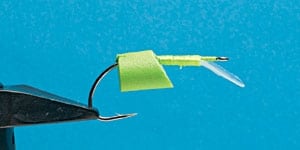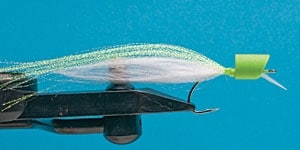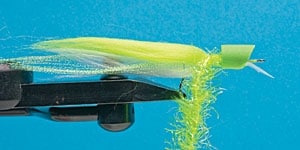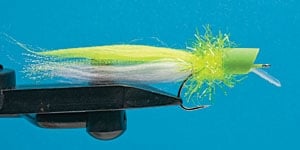
While at a meeting of the Charlotte Harbor Fly Fishers Club in Punta Gorda, Florida, I noticed a fly being passed around with great interest. An immediate thought came to mind as I looked over Doug Rose’s new creation: Why didn’t I think of that first?
The Rose Lipped Popper is basically a takeoff of the tried-and-true popper – except that it does much more. Doug was gracious enough to let me share its story with you. This pattern was designed to imitate a suspended twitch lure, which is very popular in our area’s shallow creeks, rivers and canals. It originally began as a Popovics’ Bob’s Banger with an attached lip but eventually morphed into Doug’s own design. It can be tied to imitate baitfish, crabs or shrimp. While deeper-running flies tend to foul frequently in Charlotte Harbor, Doug’s fly tracks just about right, and he’s taken snook, redfish, trout and juvenile tarpon on it.
Smaller or larger heads can be used to customize this fly, but a – or ½-inch diameter piece of foam is generally used. The engine that truly makes the Rose Lipped Popper work, however, are Flylipps, which are injection-molded lips that allow the pattern to dive and swim. We prefer a shallow-running fly in our area, but Flylipps can be trimmed to allow for deeper tracking with less side-to-side action.
Polar Fiber is used for the tail, which creates a baitfish-like swimming action and stable orientation. The hook, tail and foam diameter must be balanced so the fly sits at a 45-degree angle in the water, with the Flylipp lying parallel to the surface. Because of the constant popping – as well as pressure imparted on the Flylipp – the thread is wrapped as far as possible up the lip for strength. After much experimentation, Doug relies on the light-wire Tiemco 8089NP No. 6 hook matched with a -inch diameter foam head for optimal balance.
Fishing this fly is fairly simple. It’s best used with a 6- to 9-weight rod and a floating line, although an intermediate line can be very effective. The Flylipp forces the popper to dig under the water’s surface, and the 90-degree angle created in the popper head and Flylipp generates air bubbles and a nice popping sound. Retrieving the fly faster, with longer strips, will increase the vibration. The pattern can also be fished effectively on the surface by letting it sit for a moment and then twitching it in short strips.
Doug doesn’t offer his poppers for sale, but he developed www.lippedpopper.com to address the many inquiries he’s received on the fly. It’s a great resource for a great pattern.
Materials
Hook: Tiemco 8089NP, No. 6
Head: Chartreuse foam cylinder, 38-inch diameter
Thread: Danville chartreuse flat-waxed nylon, 210-denier
Body: Chartreuse Estaz Grande
Tail: White and electric yellow Polar Fiber Craft Fur
Lip: Flylipp
Flash: Fluorescent chartreuseKrystal Flash
Glue: Loctite Easy Brush Super Glue
Other: Scratch awl
Tying Instructions
| Step 1: From a 38-diameter foam cylinder, cut a 916-inch piece after pencil-marking a 30-degree angle on one end. Cut along the pencil line with a single-edge razor blade. Heat the tip of a scratch awl with a lighter and pierce the cut-foam cylinder off-center. | |
| Step 2: Thread-wrap hook from the eye to the bend. Coat thread with head cement. Then brush Super Glue inside the handle of the Flylipp, and tie in the same side as the hook point. Remove hook and start the foam cylinder over the hook point. Place hook back into vice and brush Super Glue on the thread, covering the Flylipp handle. |

| | Step 3: Push the foam head as far up the lip as possible, and tie in a 2- to 3-inch length of white Polar Fiber directly behind the foam cylinder on top of the hook. (Don’t forget to comb out short, bulky excess fiber prior to tying in.) Then tie in a generous amount of Krystal Flash over the Polar Fiber.|

| | Step 4: Tie in a top layer of combed electric yellow Polar Fiber. Coat the thread with Super Glue and then tie in several inches of chartreuse Estaz Grande. Wrap the Estaz around the collar of the fly and then tie off to a whipped finish.|

| | Step 5: Trim to your desired length and go fishing!|

|









